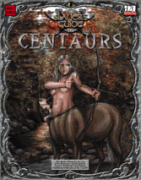
|
About OgreCave and its staff
|

|
by Matthew Pook
This book again adheres to their standard 32-page format. It sports a very nice cover painting by Anne Stokes, which although still dark, is very much an improvement upon the covers of the first two books. Internally the art is decent, but given to inconsistency, as some of it is perhaps a little too cartoon-like. Further, one piece suffers from poor perspective, highlighting the difficulty of the right composition for a race that is half human and half horse. Another gripe I have with the book's presentation is the choice of art used on the outside of each page. This depicts a wall hung with weapons ready for use, and while this was fine for the books on Hobgoblins and Gnolls, it is hardly appropriate for a race that dwells in deep forest glades. The Slayer's Guide To Centaurs brings the race to life by examining various aspects of their background, culture and society, though their physiology is pretty much glossed over. We learn that centaur society is matriarchal, with the females being of the majority of any village population, making the decisions, and being responsible for running and organizing the villages in which they live. Their place is to see to the guidance and well being of everyone within each village. Males do much of the physical labour: the hunting, foraging and growing of food, as well as the patrols that see to the safety of their home. Though males see themselves as being under the guidance of the females, they also see themselves as being free once outside of their village. This tendency increases after having imbibed any alcohol, which drives them into great acts of horseplay (ahem). Only males brew or drink alcohol, of which they can be considered to be connoisseurs, and will happily trade with the elven nations for the best. Centaur druids can only be female, and it is the wisest of each village's druids that leads them. In addition to administering to the religious needs of the village, each druid also uses her magic to augment the traps and snares that the males place around the village for its protection. Unfortunately, the nature of how druidic spells are used for this, and how they are used on the rare occasions when the village's males go to war, is left to the imagination of the DM or player. It would have been good to see some guidelines covering this area, but there are none given in the book. The Centaur's place as part of the ecology suffuses every part of their lives. They do not revere or worship nature so much as they are part of it. This goes some way to explaining their woodland sixth sense. It also explains their attitude towards anyone who treats their homeland with disrespect or destructiveness. They have little trust for any other race save the woodland elves, regarding mankind and the dwarves with apprehension, and holding both orcs and half-orcs in nothing but contempt. The section upon the centaur in war concentrates upon their prowess with the longbow, club and lance, and their ferocious battle charge. The centaur's usual tactics are to drive off through ambush, the races that encroach upon the deep forests that they make their home in, but they will hunt down and kill both orcs and half-orcs. The Slayer's Guide To Centaurs is rounded out with a guide for running centaurs as player characters and several scenario hooks and suggestions. These provide a variety of different ideas, even plausible ones that embrace the book's title as a Slayer's Guide and put an ordinary party of characters up against a village of centaurs. Each of the ideas can also be used in conjunction with the sample village, Lanhyd. This is fairly small by average centaur standards, but is nevertheless a useful starting point for any DM. This entry in the series is not quite as useful as the previous two. For one thing, both the hobgoblin and the gnoll races are far more common! Yet there is still opportunity for some decent play within this sourcebook – persuading a centaur village that they have only friendly intentions is a roleplaying challenge in itself. One interesting way in which to use The Slayer's Guide To Centaurs is in combination with either of the books on hobgoblins or gnolls. Both humanoid species are described as often being on the move in the search for a new home, and this could be near the glade of a centaur village. Here there is scope for the DM to run a short campaign with players as any of the three races.
|
||
 After two books about foes to kill – The Slayer's
Guide To Hobgoblins and The Slayer's Guide To Gnolls –
After two books about foes to kill – The Slayer's
Guide To Hobgoblins and The Slayer's Guide To Gnolls –